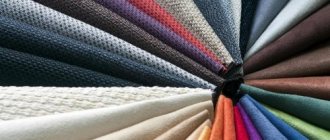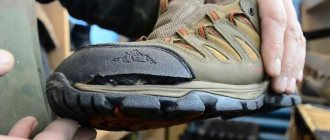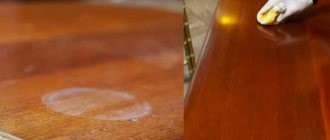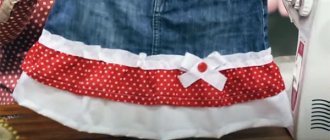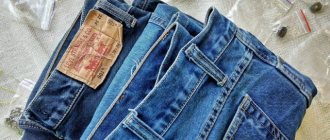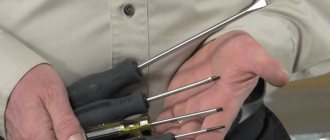Fashion is a capricious lady.
What was trendy last spring does not always look stylish next season. In pursuit of global trends, you shouldn’t frantically run for a new midi or maxi dress. After all, you can lengthen a skirt or dress at home yourself using existing ones. Today we’ll look at how to do this so that the product not only doesn’t lose its appearance, but also looks stylish.
In what cases is it necessary
You always want things to fit perfectly and keep their shape after washing. Often, due to lack of time, you have to do everything on the run. A quick try-on can result in disappointment at home, and the poor-quality composition of your favorite product can upset you after the first time it goes into the washing machine.
It also happens that the purchased dress has become inappropriate for office work. The color, style, fabric are suitable - everything except the length. And sometimes the very texture of the material forces the hem of the dress to rise, at the slightest opportunity exposing the legs for everyone to see, thereby creating awkward situations. The answer to the question of what to do if the dress has become short is obvious: first of all, do not fall into despair. It can always be extended.
Spectacular train
If you want to combine both mini and maxi, a removable skirt is the ideal option. It can be solid, with a slit in the front, with an asymmetrical hem, or with a cascade of flounces. This is a current and fashionable trend. This detail goes well with elegant dresses.
Suitable materials are: guipure, transparent chiffon, pleated fabric, lace fabric. The color scheme of the removable skirt should ideally match the dress. The easiest way to make this detail is with a soft, knotted belt, satin ribbon.
A flying train will completely change the style of the outfit.
The part is easy to sew. The base can be a rectangle; two widths of the canvas are taken. It needs to be evenly gathered around the waist, and a belt with hooks or a ribbon should be sewn on. In the asymmetrical version, the fabric is folded in half and the bottom line is smoothly rounded.
You can take the sun as the basis for the pattern. Leave the seam open at the front and gently round it to the main length. Place folds at the waist, opening the legs slightly in front. It turns out to be a very impressive outfit.
If you don't want to bother with lengthening, find out how to create a new dress from scrap materials in 30 30 minutes.
Ways to add length
Ideas for lengthening a short dress will not only help solve the hem problem, but also decorate the item, turning it into a creative, modern piece of clothing. It often seems that only a professional tailor can cope with such a task. That is why many people wonder: is it possible to lengthen the dress yourself. The answer is clear - of course. Many options will not only save precious budget and time, but also allow you to show maximum creativity at minimal cost.
Using lace or flounce
One of the easiest ways to lengthen a dress with your own hands is to sew a strip of material to its hem. To avoid damage to the appearance, you need to use exactly the same fabric as the one from which the product is made. If there is no piece of identical material, it is worth playing with contrast.
A slight difference in color or texture of the material or its weaving will be noticeable. Even a difference in one tone or another texture is noticeable. This greatly spoils the appearance of the dress.
You can lengthen the hem:
- Wide lace braid. Elegant openwork weaving is suitable for light summer dresses made of viscose, silk or other flowing materials. The color is selected to match the main shade. If you are interested in how to lengthen a short denim dress, then lace will be one of the most successful options. Its beige or white shade without shine will emphasize the color of denim, playing on the difference in fabric textures. Thick bouclé fabrics for autumn-winter clothing also go well with this type of trim, but the shade of the insert should be darker than the main material.
- A shuttlecock made of fabric. By choosing a material that is identical or similar in composition, you can decorate any dress, regardless of season and style. In this case, you should carefully consider the choice of color. To create a more complete look, you can further decorate the sleeve cuffs or collar area.
When lengthening the hem with lace or fabric, special attention should be paid to the pomp. To get a large volume of flounces, you need to sew twice as much material as the total length of the hem. Fluffy elements are suitable for a straight, tight knitted outfit. If you just need to lengthen the clothes, then the fabric is taken in a 1:1 ratio. The flounces can be attached to the front or inside of the skirt. When choosing a way to lengthen a short linen dress, you need to take into account that the material loses its shape when worn, so massive ruffles are not suitable for this type of fabric.
In order to sew a fluffy hem, regardless of the type of fabric or braid, you must first thread the piece with a needle onto a long thread, straighten it evenly along the entire length, and only then sew it onto the bottom of the garment.
Lengthening a dress with lace
Extension with flounce
Making inserts on the skirt
Surely many have wondered: is it possible to lengthen the hem of a dress using an insert at the bottom. It is recommended to add them at the seams or by cutting the edge of the dress. If you make wedges that exceed the length of the product by 10-20 cm, the skirt will appear visually larger. Guipure, mesh, and lace are great for this method. As a result of such alterations, things are obtained with an echo of Spanish culture.
Particular attention should be paid to symmetry when inserting wedges. If you carefully observe the dimensions from the middle on both sides, the result looks like a factory one. If this rule is neglected, the alteration will be noticeable immediately.
Master class on lengthening a dress using inserts
Tools for work
Lace braid from 5 cm wide
Measure 11 cm from the edge of the hem and cut straight
Finish the edges with an overlock or zigzag stitch
Turn the finished seams to the wrong side, baste and iron
Sew the braid to the dress
Ready-made long outfit
Waist extension
When choosing how to lengthen a short dress, you should know that the methods are not limited to just increasing the size of the hem. Many models have a seam at the waist. If you add an insert in this place, the length of the bottom will drop by its width. By using contrasting colors, you can focus on the graceful silhouette, and using different materials, you can highlight the texture to your advantage. This method is recommended for sun or semi-sun style products. Lengthening the dress at the waist for an a-line is also possible, but it all depends on the width of the cut angle.
If the material for insertion is similar, but does not quite match the main type of fabric, when combined with lace, guipure or mesh, you can visually hide the discrepancies.
Bodice extension
Options for changing clothing are not limited to the hem and waist area. In some cases it is possible to lengthen the bodice. This method will look especially beneficial on dresses in the style of Marilyn Monroe with a wrap around the bust area.
Adding fabric to the bodice area will be most preferable for styles such as sheath, pencil. When choosing a way to increase the length of a straight silhouette dress, do not forget about the importance of color. A contrasting strip of fabric will visually highlight the bust. If you need to distract attention, you can divide the total width of the material in half and insert the first half into the bodice, and add the second half to the hem.
Creating a high waist
One way to lengthen a straight dress is to change the silhouette by creating a high waist. This option is not suitable for flared styles, since alterations in clothing will be too obvious. The procedure looks like this:
- select a suitable piece of fabric;
- cut out the strip evenly;
- fasten with safety pins;
- stitch;
- we process the seams.
If you don’t have much sewing experience, after pinning the wedge with needles, you should baste the parts together from the wrong side. This is done to ensure that the seam is even when sewing.
Using cap elements
If you need to add length to dresses for special occasions, you can use cape elements. This option is stylistically not suitable for everyday wear, as it looks too elegant and pretentious. Throw-on elements will advantageously set off models made of shiny fabrics, giving them an even greater touch of solemnity.
You should not use this method on silhouettes with flared hems. Hanging flounces will be lost against the background of the folds of the skirt and will not retain their shape or visual effect.
For work, fabrics that hold folds well are used, for example, a veil. To make it, you need to hang the dress on a hanger, use safety pins to secure the textile with the required number of folds, and sew it. It is worth strictly ensuring that the shuttlecocks look symmetrical, preferably measuring the dimensions with a ruler or centimeter.
Another option for the cape method would be to make a translucent fabric with an identical cut, but longer, single-tiered or multi-tiered skirt. Usually it is fastened over the dress, turning it into a transformer. A transparent case looks great in the form of a longer, but repeating the cut of an outfit made of veil or lace. This method requires more fabric, but the results are worth it.
Creating a loop
Evening dresses attract attention with their style, decor and cut elements. It is this style that is more conducive to experimentation than others. Extension along the hem is possible not only with a straight strip, but also with geometrically irregular lines. The train on such a dress looks appropriate, adding zest to the image.
When making it, you need to be careful: a train that is too short or too long will look like an obvious homemade product. First you need to choose the right material. Next, divide it into several parts - front and back. It would be optimal to reduce the length of the first part by half. The back part is folded in half, the elongated middle and short side edges are marked, an even straight line is drawn, and then the material is cut. After this, both parts are sewn in the same way as a shuttlecock. Short clothes, improved in this way, can be complemented with inserts on the sleeves or matching jewelry. If the style and texture of the fabric match, creating a train will be the best way to lengthen the back of the dress.
Lengthening a knitted or denim dress
Knitwear and denim are a separate line in the list of fabrics for everyday wear. The softness of the first and the texture of the second do not provide much scope for creativity. Therefore, we lengthen a denim dress only with the help of flounces and lace. Both methods can be performed by beginning craftswomen. Methods for lengthening a denim dress do not involve changing the cut due to the stitching, the violation of which is immediately noticeable. For a knitted outfit, you can use inserts made of artificial leather, translucent fabric in the chest and waist area.
Sew lace to the hem of the dress
This is perhaps the simplest and at the same time quite effective way to add length to a dress, while at the same time making it more elegant. It is enough to sew lace to the hem - and a discreet outfit will turn into a flirty, slightly mysterious one. Lace will transform both a straight silhouette and a bell or flare.
When choosing finishing material, it is important to consider its compatibility with the fabric of the dress itself. The lace can be matching or contrasting, thin or denser. Its width depends on how much the product needs to be lengthened.
Sometimes, if you want to lengthen the model quite a bit, it is advisable to add the same lace to the cuffs, neckline or waistline. This way, the thin strip at the bottom won’t look alien.
A similar option for cases where a slight extension is required is decorative braid. It is also better to repeat it somewhere along the top.
Choose the texture of the lace in accordance with the texture of the main fabric. If it is not elastic, then the finish should not be either. Otherwise, the possibility of defective work cannot be ruled out: it is not always possible to sew stretch lace without seating.
Decorating inserts
The final appearance of the product depends on the material used for the inserts, so you should choose it carefully. Stylists advise using not only plain fabrics, but also striped and polka dot colors, the main tone of which matches the color of the dress. Leather and substitute inserts are recommended as universal, suitable for any fabric texture. Finished elements, if necessary, are decorated with rhinestones, beads, sequins or beads. And if bright decor does not always look good on a casual dress, then on an evening or cocktail dress the elements will sparkle.
When solving the problem of how to beautifully lengthen a summer dress or clothes for the cold season, you need to understand that most of the options can be done with your own hands. What looks like a complex design creation is actually easy to complete with a little time and research. By changing the length of the dress, you can not only create a new product, but also show your creativity to the maximum.
How to lengthen the sleeves on a dress?
If the sleeves require lengthening along with the product itself, you can use the same techniques that were chosen for the outfit itself: one or more inserts, lace, braid.
If only the sleeves are lengthened, then it is logical to repeat such finishing elements on the dress itself (make “false inserts” by stitching the trim on top).
But you can choose other solutions that can change the appearance of the model. In particular, the cuffs. There are many varieties of shapes and materials for them:
- Classic cuffs (similar to men's shirts). They can be further trimmed, for example, with a pleated frill.
- Ruffle cuffs (in one or several layers). Sometimes, in order for such a solution to look harmonious and proportional, it is necessary to cut off the sleeve a little more.
- Flounced cuffs. The option is similar, but looks more classic and feminine.
- Lace cuffs. Can be quite high. Suitable for light fabrics.
- Bow-shaped tie cuffs.
- Turned cuffs. Suitable for sporty and classic clothing styles.
- Cuffs made of fur or knitted fabric with imitation fur. More suitable for autumn-winter wardrobe.
It's not just the cuffs that are fur. Instead, you can use inserts in the upper third of the sleeve. The main thing is that such a solution looks organic with the outfit as a whole.
There are many opportunities to add length to a product. The main thing here is not to spoil it by altering it. And for this it is important to harmoniously select both the finishing materials themselves and the method of using them in a particular model.
Lengthening and shortening the pattern | Blog
I measured S the other day. She continues to grow and I was curious to know her size now that she is five. She is a very long and skinny baby, so I was not surprised to learn that she has a size 3 waist, chest and hips and a size 5 height.
Most likely, you are faced with a similar problem. You're ready to sew for your child (or yourself), but the size of the body the garment will be worn on is different from the size chart on the pattern envelope.
Don't worry. It's easy to make changes to the pattern to accommodate these differences. I've put together a little tutorial to show you how to do this.
Choosing the right welding location
First, assemble all the pieces you want to lengthen or shorten. It's important to make the same changes to all the matching pieces, so make sure you have pieces for the front and back of the garment.
Generally, the best place to lengthen or shorten a dress or shirt is midway between the bottom of the armhole and the hem. For pants or a skirt, the best place is midway between the rise/crotch and the hem.
Here are some illustrations showing (with a horizontal line) the recommended lengthening/shortening locations for some of our patterns.
Sailboat Top Sleeve: Extend halfway between armpits and hem Sandbox Pants: Extend halfway between instep/crotch and hem Tea Party Sundress: Extend skirt halfway between top hem and hem
By adding or subtracting length in the middle of the piece, you won't affect the hem or overall silhouette as much as if you added to the bottom of the piece. However, use common sense here. Depending on the style, you may want to choose a slightly different weld location.
I prefer to lengthen or shorten at the notch (when the notch is available) so that I can be sure to place matching or opposing pieces in the same place. For example, on the Sundress for tea drinking, I lengthened the lower of the double slits. Don't forget to do this for all parts involved: front and back!
Once you have chosen the location where you will make the seam, draw a line on the pattern at that location. The line should be perpendicular to the grain (or fold) line at the point where you want to lengthen or shorten the piece. Remember: Draw this line in the same place on all pattern pieces that you will be changing.
Then, starting with one piece, cut the pattern along your line to separate it into two separate pieces.
For lengthening
To increase the length of the pattern, attach a strip of paper under one of the two pieces and draw a grain line (or fold line) across the strip of paper as shown in the picture below.
Draw a line parallel to the cut edge of the pattern and mark the length you want to add. For S, I usually add one to two inches, but it's a good idea to refer to the finished garment measurement chart on the back of the pattern envelope so you know how long the original pattern will be when it's finished. This will help you decide how much to add or subtract from a portion.
Glue the other pattern piece to the drawn line. Be sure to match the extended grain line, even if the sides of the pattern don't match.
Finally, draw the edges of the pattern onto the strip of paper you inserted. You will need to draw a straight line or a curve. If the edge is straight, simply connect the two sides of the original pattern piece with a line. If the edge is curved, you may need to blend the edge by subtracting a little from one line and adding to the other. Use your eye to widen the curve so it looks blended with the rest of the edge of the pattern, like in this illustration.
To shorten
To shorten a pattern, fold the pattern piece over itself to remove any excess length and glue the pieces together, again maintaining the grain structure or fold line.
Redraw the sides, blending any curved lines to create a continuous curve, as you would with an elongated piece.
Sandbox Pants: Overlap the cut line to shorten
. Again, be sure to make the same adjustments for all pattern pieces, both front and back. There's nothing worse than forgetting to add length to a piece of the pattern.
similar positions
.
